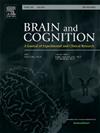自闭症和分裂型特质维度如何影响神经预测加工:事件相关电位研究
IF 1.4
3区 心理学
Q3 NEUROSCIENCES
引用次数: 0
摘要
预测处理框架提供了对自闭症和精神分裂症谱系的神经机制的见解。这项研究采用不同难度的视觉和听觉古怪任务来测试大脑对意外事件的反应是否在这些光谱中有所不同。共有122名参与者接受了脑电图记录,并完成了自闭症和分裂型特征的自我报告。结果表明,任务难度的增加显著降低了两种感觉模式的P300振幅。较高的限制性兴趣和细节取向自闭症特征与困难视觉任务的N2波幅增强有关,但在P300时间窗中没有影响。贝叶斯分析得出了适度的证据,证明P300振幅与自闭症特征和分裂型之间没有任何可靠的联系。早期听觉N1-P2与分裂型特征没有可靠的关系,只有与自闭症沟通困难微弱的任务依赖关系。我们的研究促进了自闭症和精神分裂症神经变异性的文献,强调了症状特异性研究的重要性,并为更有针对性地研究预测加工机制铺平了道路。此外,交流与限制兴趣特征的不同研究结果强化了自闭症的社会维度和非社会维度依赖于不同的神经过程的观点。本文章由计算机程序翻译,如有差异,请以英文原文为准。
How distinct autism and schizotypal trait dimensions influence neural predictive processing: An Event-related potential study
The Predictive Processing framework offers insights into the neural mechanisms underlying autism and schizophrenia spectra. This study employed visual and auditory oddball tasks with varying difficulty levels to test whether brain-responses to unexpected events are different within these spectra. A total of 122 participants underwent EEG recordings and completed self-reports of autistic and schizotypal traits. Results showed that increased task difficulty significantly reduced P300 amplitudes across both sensory modalities. Higher Restricted Interests and Detail Orientation autistic traits were associated with enhanced N2 amplitudes in the difficult visual task, but there were no effects in the P300 time-window. Bayesian analyses yielded moderate evidence against any reliable association between P300 amplitudes and both autistic traits and schizotypy. Early auditory N1-P2 showed no credible relationships with schizotypal traits and only weak, task–dependent associations with autistic communication difficulties. Our study contributes to the growing literature on neural variability in autism and schizophrenia, emphasizing the importance of symptom-specific research and paving the way for more targeted investigations on predictive processing mechanisms. Moreover, the divergent findings for communication versus restricted-interests traits strengthen proposals that social and non-social dimensions in autism rely on distinct neural processes.
求助全文
通过发布文献求助,成功后即可免费获取论文全文。
去求助
来源期刊

Brain and Cognition
医学-神经科学
CiteScore
4.60
自引率
0.00%
发文量
46
审稿时长
6 months
期刊介绍:
Brain and Cognition is a forum for the integration of the neurosciences and cognitive sciences. B&C publishes peer-reviewed research articles, theoretical papers, case histories that address important theoretical issues, and historical articles into the interaction between cognitive function and brain processes. The focus is on rigorous studies of an empirical or theoretical nature and which make an original contribution to our knowledge about the involvement of the nervous system in cognition. Coverage includes, but is not limited to memory, learning, emotion, perception, movement, music or praxis in relationship to brain structure or function. Published articles will typically address issues relating some aspect of cognitive function to its neurological substrates with clear theoretical import, formulating new hypotheses or refuting previously established hypotheses. Clinical papers are welcome if they raise issues of theoretical importance or concern and shed light on the interaction between brain function and cognitive function. We welcome review articles that clearly contribute a new perspective or integration, beyond summarizing the literature in the field; authors of review articles should make explicit where the contribution lies. We also welcome proposals for special issues on aspects of the relation between cognition and the structure and function of the nervous system. Such proposals can be made directly to the Editor-in-Chief from individuals interested in being guest editors for such collections.
 求助内容:
求助内容: 应助结果提醒方式:
应助结果提醒方式:


